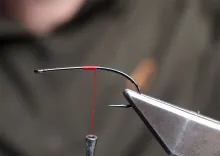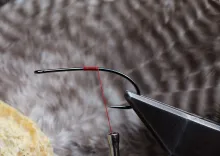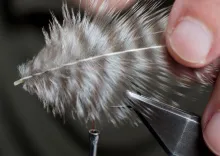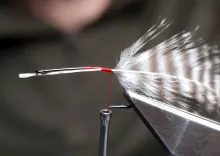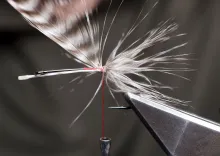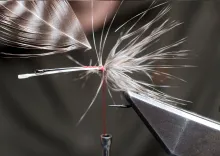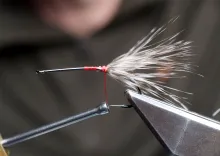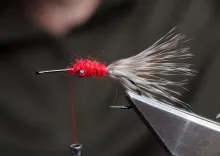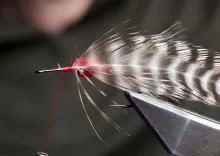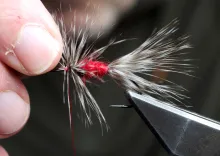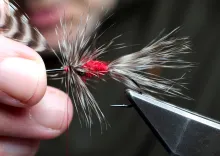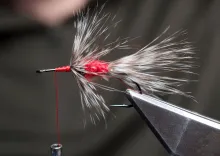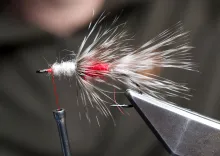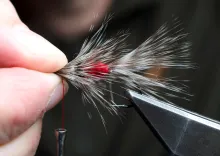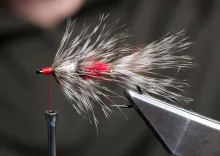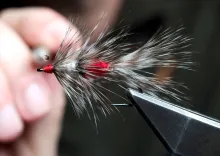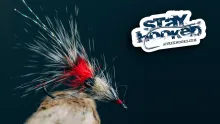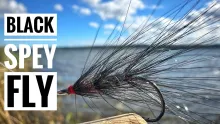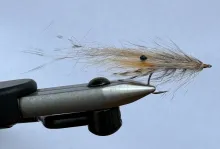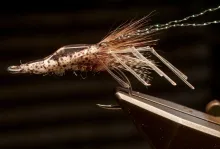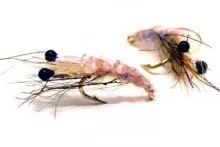Raccoon – or Vaskebjørn – is a highly successful and good looking Norwegian sea trout fly.
I first heard of the Raccoon from Eivind Berulfsen, a very active Norwegian fly tyer and fly angler. Eivind mentioned it several times in his online posts and uploaded pictures and tying videos featuring the fly. A very good looking fly, shrimp-like and not far from many typical Danish sea trout flies. Eivind of course called the fly Vaskebjørn, its Norwegian name, which is the same in Danish. That's the common word for the small, masked animal in both languages.
Eivind may have
made it popular through his YouTube channel and frequent online postings, but the pattern was originated and first tied by another Norwegian, Christian Schanche, who told me about the origin of the fly:
- It came about in the middle of the 90’s as a hybrid between some of my favorite sea trout flies, the Omoe Brush, the Frede and the Magnus. I placed the bead chain eyes further back to get a more balanced fly moving like a shrimp or a stickleback. My good friend Eivind Berulfsen added the red seal fur, and the fly got its name during a fishing trip to Danish island Bornholm, inspired by a few Carlsberg and maybe a schnapps or two.
Christian continued:
- The fly is a great all-rounder, which can be fished slow and fast, figure of eight or in strips. I have taken 13 sea trout in the 4-5 kilo range on this fly on Bornholm alone, and many other anglers report that the fly takes large fish.
So, the fly is obviously highly productive, and has become quite popular in the Baltic. It has been used extensively in both Norway, Denmark and Sweden mostly by Norwegian and Swedish anglers, but is also catching on in Denmark and could definitely be used in many other places for any fish that eat shrimps and small gray baitfish.
Trond Hagen
The fly is tied
with several sections divided by hackles like many flies such as the already mentioned Omoe Brush, the Djihad, Brenda, the Swedish salmon fly Ullsock and many more, quite a few of these owing a lot to the Irish shrimp and grub flies for salmon. In the case of the Raccoon there’s a round of hackle forming the tail, a red dubbing section with the eyes, another hackle, a lighter dubbing section, a hackle and a final small light section and a small front hackle.
All the hackles can be made from one large grizzly feather. A large, saltwater style saddle can deliver the proper feather, but one might also be found on the sides and top of many of the coarser dry fly saddles. You need one or a couple of feathers with fairly long barbs, the longest ones being 1½ even 2 times the hook gape. As you work your way forwards on the hook, using parts of the feather closer to the tip, you get a natural taper to the fly, the final frontal hackle being quite small. The red dubbing and the red head offer some contrast, and if you use genuine seal’s fur, you even get the almost magic translucency and shine that’s found in this material. Light is caught and reflected in the material in a quite special way.
Two or three sections
The original Racoon was tied in four sections with the tail and three hackles. Many current versions are tied with only two sections - a red and a light one - separated by a single hackle and finished with one in the front. In this configuration the fly is lighter and more airy and faster to tie, which is preferred by many.
Calle Eklind
I have used some red and gray Polar fox in the fly below. It looks fine, but I'm pretty sure that the seal's fur used in the original has some "magic" capabilities when it comes to reflecting light mentioned above. Many of the furs on arctic animals such as Polar bear, seal, snow hare and Arctic fox has a very special luster that probably comes from the ability to absorb and disperse certain bandwidths of light in order to keep the animal warm.
|
|
|
|
|
|
|
|
|
|
|
|
|
|
|
|
|
|
|
|
|
|
|
|
|
|
|
|
- Log in to post comments


















